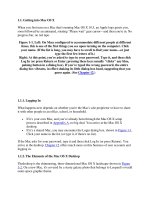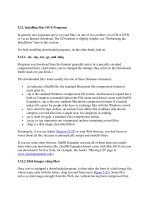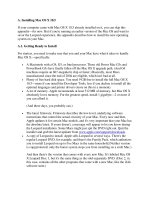Mac OS X Server Introduction to Command-Line Administration Version 10.6 Snow Leopard phần 5 pptx
Bạn đang xem bản rút gọn của tài liệu. Xem và tải ngay bản đầy đủ của tài liệu tại đây (230.75 KB, 10 trang )
Chapter 5 Common Command-Line Tasks 41
Key Command Action
J or Down Arrow Scroll down a line
K or Up Arrow Scroll up a line
N Find the next occurrence of a search term
P Find the previous occurrence of a search term
Q Quit
less
For more information about the less command, see its man page.
Searching for Text in a File
To locate a string within a le, use the grep tool. The grep tool searches the named
input les for lines containing a match to the given pattern. By default, grep prints the
matching lines.
To search for a unique string in a le:
$ grep search_string filename
Replace search_string with the the string to search for, and replace lename with the
name of the le whose contents you want to search.
Backing Up and Restoring
Time Machine is extremely useful for user backups, but server administrators might
have dierent backup requirements. Mac OS X Server provides several command-line
tools for backing up and restoring data:
 rsync—Use this command to keep a backup copy of your data in sync with the
original. rsync copies only the les that have changed.
 ditto—Use this command to perform full backups.
 asr—Use this command to back up and restore an entire volume.
For more information about these commands, see their man pages.
Note: You can use these commands with the launchctl command to automate
data backup.
42
Learn how to access hardware-level controls like restarting,
shutting down, powering up, and selecting boot options
from the command line.
This chapter introduces commands for shutting down or restarting a local or remote
computer. Computers need to be shut down or restarted, whether locally or remotely,
when installing tools or making computer repairs.
Restarting a Computer
To restart a computer at a specic time, use the reboot or shutdown -r command.
For more information, see their man pages.
To restart the local computer:
$ shutdown -r now
To restart a remote computer immediately:
$ ssh -l root computer shutdown -r now
To restart a remote computer at a specic time
$ ssh -l root computer shutdown -r hhmm
Parameter Description
computer The IP address or DNS name of the computer
hhmm The hour and minute when the computer restarts
Automatic Restart
You can also use the systemsetup tool to set the computer to start up after a power
failure or system freeze, by specifying a number of seconds:
systemsetup -setwaitforstartupafterpowerfailure seconds
6
Accessing Apple Hardware from
the Command Line
Chapter 6 Accessing Apple Hardware from the Command Line 43
Parameter Description
seconds The number of seconds before the computer
starts after a power failure. This value must be
a multiple of 30.
Changing a Remote Computer’s Startup Disk
You can change a remote computer’s startup disk using SSH.
To determine available startup volumes:
Log in to the remote computer using SSH, and enter:
systemsetup -liststartupdisks
To change the startup disk:
Log in to the remote computer using SSH, and enter:
CodeLinesystemsetup -setstartupdisks /Volumes/SnowLeopardServerHD/System/
Library/CoreServices
For information about using SSH to log in to a remote computer, see “SSH” on page 27.
Shutting Down a Computer
To shut down a computer at a specic time, use the shutdown tool. For more
information, see the shutdown man page.
To shut down a remote computer immediately:
$ ssh -l root computer shutdown -h now
To shut down the local computer in 30 minutes:
$ shutdown -h +30
Parameter Description
computer The IP address or DNS name of the computer
Shutting Down While Leaving the Computer On and Powered
To support UPS restart after power failure, the shutdown tool provides the -u option.
This option halts system shutdown before the shutdown tool instructs the power
manager to turn o the power supply.
The -u option keeps the system halted and waits for 5 minutes before removing
power so an external UPS can forcibly remove power.
Using the -u option simulates a dirty shutdown, which allows a later automatic
power-on. The operating system uses the -u option with supported UPS devices in
emergency shutdowns.
Manipulating Open Firmware NVRAM Variables
To manipulate Open Firmware NVRAM variables, use the nvram tool. If you change
a value with nvram, the value is saved only if the computer cleanly restarts or
shuts down.
To view NVRAM variables:
$ nvram -p
For more information, see the nvram man page.
Remotely Controlling the Xserve Front Panel
You can use the ipmitool command to remotely control the front panel of an Xserve.
To display the list of supported virtual front panel commands:
$ ipmitool chassis bootdev
bootdev <device> [clear-cmos=yes|no]
none : Do not change boot device order
pxe : Force PXE boot (LOM: Force boot NetBoot server)
disk : Force boot from default Hard-drive
safe : Force boot from default Hard-drive, request Safe Mode (LOM: Not
used)
diag : Force boot from Diagnostic Partition (LOM: Force boot diagnostic
mode from NetBoot server)
cdrom : Force boot from CD/DVD
bios : Force boot into BIOS Setup (LOM: Not used)
Lights-out Management additional options
nvram : Force reset of NVRAM
tdm : Force boot into Target Disk Mode
other : Skip current startup disk selection, and boot from other
Mac OS X Server v10.6 supports the following commands: none, pxe, disk, diag, cdrom,
nvram, tdm, and other.
For example, enter the following command and then restart the Xserve system to start
the system in Target Disk Mode:
$ ipmitool chassis bootdev tdm
After the system starts, the ipmitool command reverts to the default setting (none).
Restarting the Xserve system without running the ipmitool command doesn’t change
the boot device order.
For more information about ipmitool, see its man page.
44 Chapter 6 Accessing Apple Hardware from the Command Line
45
The following command line tools are unique to Mac OS X or substantially dierent
from implementations on other UNIX platforms. See their man pages for more details.
An online version of the man pages in Mac OS X and Mac OS X server is available at:
/>Section 1 Man Pages
Man pages in section 1 refer to general command-line tools and utilities.
See the intro(1) man page for more information about this section.
afconvert(1) Audio le converter
afinfo(1) Audio le information
afplay(1) Audio le player
afscexpand(1) Decompress les compressed with HFS+ compression
amlint(1) Check Automator actions for problems
applesingle(1) Encode and decode les
ar(1) Create and maintain library archives
arch(1) Print architecture type or run selected architecture of a universal
binary
authopen(1) Open le with authorization
automator(1) Runs Automator workow
auval(1) AudioUnit validation
auvaltool(1) AudioUnit validation
binhex(1) Encode and decode les
BuildStrings(1) Generate header (.h) or resource (.r) le from text les
compileHelp(1) Command-line utility to merge contextual help rtf snippets into
one resource
Appendix
Command-Line Tools Specic to
Mac OS X
46 Appendix Command-Line Tools Specic to Mac OS X
configureLocalKDC(1) Generate a LocalKDC
CPlusTestRig(1) Runs CPlusTest unit test bundles
CpMac(1) Copy les preserving metadata and forks
createhomedir(1) Create and populate home directories on the local computer
defaults(1) Access the Mac OS X user defaults system
desdp(1) Scripting denition generator
ditto(1) Copy directory hierarchies, create and extract archives
dns-sd(1) Multicast DNS (mDNS) & DNS Service Discovery (DNS-SD) Test Tool
drutil(1) Interact with CD/DVD burners
dscacheutil(1) Gather information, statistics and initiate queries to the Directory
Service cache
dsimport(1) Tool for importing records into an Open Directory source
dsmemberutil(1) Various operations for the membership APIs, including state
dump, check memberships, UUIDs, etc
dsymutil(1) Manipulate archived DWARF debug symbol les
dwarfdump(1) Dump DWARF debug information
dyldinfo(1) Displays information used by dyld in an executable
emacs-undumped(1) Basic emacs with no ELisp libraries loaded
FixupResourceForks(1) Join AppleDouble les into two-fork HFS resource les
fs_usage(1) Report system calls and page faults related to lesystem activity
in real-time
fwkdp(1) FireWire KDP Tool
fwkpfv(1) FireWire kprintf viewer
gatherheaderdoc(1) Header documentation processor
genstrings(1) Generate string table from source code
GetFileInfo(1) Get attributes of les and directories
hdiutil(1) Manipulate disk images (attach, verify, burn, etc)
hdxml2manxml(1) HeaderDoc XML to MPGL translator
headerdoc(1) Header documentation processor
headerdoc2html(1) Header documentation processor
hiutil(1) Utility for creating and examining Help Viewer indices
hwprefs(1) Inspect and control low-level system and processor parameters
Appendix Command-Line Tools Specic to Mac OS X 47
javaconfig(1) Get Java conguration information
javatool(1) Tool used in building older Java software projects
languagesetup(1) Set the primary language
latency(1) Monitors scheduling and interrupt latency
launchctl(1) Interfaces with launchd
ld(1) Linker
locale(1) Display locale settings
localedef(1) Dene locale environment
lookupd(1) Gather information, statistics and initiate queries to the Directory
Service cache
mDNS(1) Multicast DNS (mDNS) & DNS Service Discovery (DNS-SD) Test Tool
macbinary(1) Encode and decode les
mdcheckschema(1) Simple mdimporter schema validation tool
mdfind(1) Finds les matching a given query
mdimport(1) Import le hierarchies into the metadata datastore
mdls(1) Lists the metadata attributes for the specied le
mdutil(1) Manage the metadata stores used by Spotlight
mediastreamsegmenter(1) Create segments from MPEG-2 Transport streams for HTTP Live
Streaming
memberd(1) Various operations for the membership APIs, including state
dump, check memberships, UUIDs, etc.
MergePef(1) Merge multiple PEF containers into one le
migrateLocalKDC(1) Migrates a LocalKDC
mnthome(1) Mount an AFP (AppleShare) home directory with the correct
privileges
mpgl(1) MPGL to mdoc (man page) translator
MvMac(1) Move les while preserving metadata and forks
netstat(1) Show network status
notificationconf(1)
notifyutil(1)
Notication command line utility
ocspd(1) OCSP and CRL Daemon
open(1) Open les and directories
48 Appendix Command-Line Tools Specic to Mac OS X
opendiff(1) Use FileMerge to graphically compare or merge le or directories
osacompile(1) Compile AppleScripts and other OSA language scripts
osadecompile(1) Display compiled AppleScripts or other OSA language scripts
osalang(1) Information about installed OSA languages
osascript(1) Execute AppleScripts and other OSA language scripts
packagemaker(1) Installation-package creation tool
passwd(1) Modify a user’s password
pl(1) ASCII property list utility Extract translatable strings from source
plutil(1) Property list utility
pmset(1) Manipulate power management settings
podcast(1) Podcast Producer command line tool
PPCExplain(1) Verbose description of PowerPC mnemonics
projectInfo(1) Identify build tool for software development project
pubsub(1) Utility for managing RSS/Atom subscriptions via the PubSub
framework
qlmanage(1) Quick Look Server debug and management tool
rebase(1) Changes base address of dylibs and bundles
reggie_se(1) Read and modify hardware registers
ResMerger(1) Merges resource forks or les into one resource le
RezWack(1) Combines resource and data forks of a le into a attened le
RunTargetUnitTests(1) Run unit tests for the current target
RunUnitTests(1) Run unit tests for the current target
sandbox-exec(1) Execute within a sandbox
sandbox-simplify(1) Simplify a sandbox prole created by a trace directive
sar(1) System activity reporter
sc_usage(1) Show system call usage statistics
sdef(1) Scripting denition extractor
sdp(1) Scripting denition (sdef) processor
security(1) Command line interface to keychains and Security framework
Appendix Command-Line Tools Specic to Mac OS X 49
securityd(1) Security context daemon for Authorization and cryptographic
operations
SetFile(1) Set attributes of les and directories
sips(1) Scriptable image processing system
SplitForks(1) Divide a two-fork HFS le into AppleDouble format resource and
data les
stackshot(1) Capture user and kernel space stack traces, using a kernel stack
trace facility
sw_vers(1) Print Mac OS X operating system version information
symstacks.rb(1) Capture user and kernel space stack traces, using a kernel stack
trace facility
syslog(1) Apple System Log utility
tconf(1) TargetCong command line tool
textutil(1) Text utility
tiff2icns(1) Converts TIFF to icns format
tiffutil(1) Manipulates ti les
UnRezWack(1) Split a RezWack le into separate data and resource les
unwinddump(1) Displays compact unwind information in an executable
update_dyld_shared_
cache(1)
Updates dyld’s shared cache
uuidgen(1) Generates new UUID strings
vm_stat(1) Show Mach virtual memory statistics
wai(1) Wait for process termination
xcodebuild(1) Build Xcode projects
xcodeindex(1) Indexes Xcode projects
xgrid(1) Submit and monitor xgrid jobs
xm(1) Script to get information about the installed version of GNOME-
XML
yacc(1) Parser generator
50 Appendix Command-Line Tools Specic to Mac OS X
Section 4 Man Pages
Man pages in section 4 refer to descriptions of special les and devices.
dummynet(4) Trac shaper, bandwidth manager and delay emulator
ipfirewall(4) IP packet lter and trac accounting
random(4) Better random number generator; routines for changing
generators
urandom(4) Better random number generator; routines for changing
generators
Section 5 Man Pages
Man pages in section 5 give information about le formats and conventions.
See the intro(5) man page for more information about this section.
asl.conf(5) Conguration le for syslogd(8) and aslmanager(8)
auto_master(5) Automounter master map
autofs.conf(5) automount(8) and automountd(8) conguration le
bom(5) Bill of materials
bootparams(5) Boot parameter database
bootptab(5) Internet Bootstrap Protocol server database
compat(5) Manipulate compatibility settings
fstab(5) Static information about the lesystems
group(5) Format of the group permissions le
launchd.conf(5) launchd(8) conguration le
launchd.plist(5) System wide and per-user daemon/agent conguration les
manpages(5) An introduction to manual pages
plist(5) System wide and per-user daemon/agent conguration les
property list format
ranlib(5) Archive (library) table-of-contents format
resolver(5) Resolver conguration le format
sdef(5) Scripting denition le
stab(5) Symbol table types
types(5) Mime type description le for cups system data types









